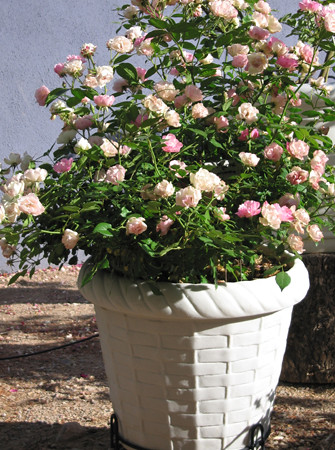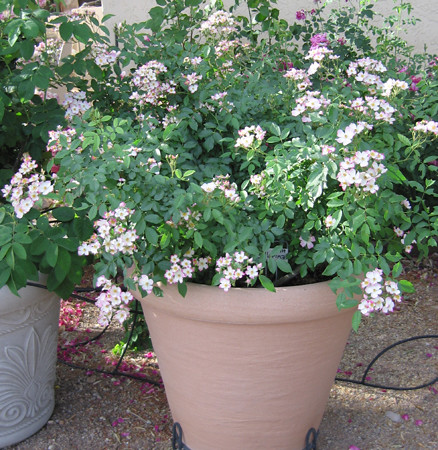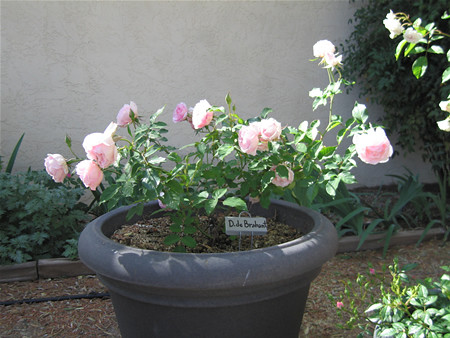 When I had my open garden this spring people were surprised that many of my roses were in pots. Ever since then I have wanted to write about my observations about using pots in the desert.
When I had my open garden this spring people were surprised that many of my roses were in pots. Ever since then I have wanted to write about my observations about using pots in the desert. CONS: It is true that roots dry out and get hot faster for plants in pots. Additionally, our winds here in Tucson have knocked over many of my larger roses and damaged their canes and root systems. And finally, potted plants must be re-potted every 3-4 years when the soil line shrinks because of loss out the bottom and compaction. That isn't a problem with small plants but it is not fun to pull a 10 ft. rose out of its pot. Some gardening books will also tell you that you need to fertilize more often and that it is impossible to mulch but I have not found this to be true.
CONS: It is true that roots dry out and get hot faster for plants in pots. Additionally, our winds here in Tucson have knocked over many of my larger roses and damaged their canes and root systems. And finally, potted plants must be re-potted every 3-4 years when the soil line shrinks because of loss out the bottom and compaction. That isn't a problem with small plants but it is not fun to pull a 10 ft. rose out of its pot. Some gardening books will also tell you that you need to fertilize more often and that it is impossible to mulch but I have not found this to be true.  PROS: Pots allow you to move a plant that needs more protection from the wind or sun, as well as to control the quality of its soil more easily (our native soil is dreadful for roses). Re-potting lets you check the health of a plant's root system: I have discovered crown gall and grub infestations during the repotting process. And finally, if you have large aggressive trees it is easier to protect the plants from root competition. Many of Tucson's most experienced Rosarians (Les, Terry, Lou and Judy) also keep their roses in pots, so I am in good company.
PROS: Pots allow you to move a plant that needs more protection from the wind or sun, as well as to control the quality of its soil more easily (our native soil is dreadful for roses). Re-potting lets you check the health of a plant's root system: I have discovered crown gall and grub infestations during the repotting process. And finally, if you have large aggressive trees it is easier to protect the plants from root competition. Many of Tucson's most experienced Rosarians (Les, Terry, Lou and Judy) also keep their roses in pots, so I am in good company.Here's what I have developed as "best practices" for my yard:
About the pots
Use light-colored synthetic pots of good size. True terra cotta is lovely but it is too porous and dries out too easily. I have my cacti and succulents in terra cotta and my roses in plastic or foam pots.
--New roses are in pots that are 6-8 inches across.
--Mature miniatures and patio roses are in pots 8-12 inches across.
--Standard roses and climbers are in 20-24 inch pots.
I learned the hard way that the cheapest pots that the hardware stores sell (thin plastic usually colored beige, green or terra cotta) sun-rot in about a year. They're just not worth the money in the long-run. On the other hand, all of my foam, thick plastic or double-walled pots have lasted for 7 years and counting.
About the soil
I like Uni-gro potting soil which doesn't have a whole lot of pricey additives, but just the right amount of peat and vermiculite. To this I will add triple super-phosphate and occaisionally epsom salts to aid root growth. I try to get a soil line about 1 inch from the rim to allow for mulch.
To protect from tree roots and cut down on sow bugs and crickets many of my roses are slightly raised above the ground on plant trivets. An added plus is that the antelope squirrels and lizards love the cool shade under the roses.
My garden is totally organic, and it gets better every year. Every year I notice more lacewings, crab spiders and lady bugs and fewer aphids and white flies. Most of the damage to my roses these days is caused by pack rats and quail (quail eat the young growth but only in the spring when they are laying their eggs). We trap the rats and tolerate the rest.
No comments:
Post a Comment